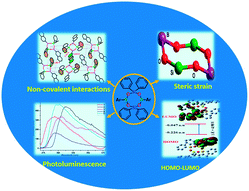Eight membered cyclic-borasiloxanes: synthesis, structural, photophysical, steric strain and DFT calculations†
Abstract
Eight-membered cyclic borasiloxanes, Ph2Si[OBArO]2SiPh2 [Ar = 4-EtC6H4 (1), 4-tBuC6H4 (2), 2-PhC6H4 (3), 4-PhC6H4 (4) and β-C10H7 (Nap) (5); Ph = phenyl], were synthesized via the reaction of diphenylsilanediol with aryl boronic acid through a condensation reaction. The compounds were characterized using elemental analysis, FT-IR and NMR (1H, 13C, 29Si and 11B). The compounds 1, 3 and 5 were further confirmed using single crystal X-ray diffraction studies. This showed the eight-membered ring (B2O4Si2) configuration and that organic substituents occupied the axial and equatorial positions. Furthermore, non-covalent C–H⋯π and π⋯π interactions were observed in the crystal packing pattern. These borasiloxanes exhibited strong solid state fluorescence. The thermal behavior of the compounds 1–5 has been investigated using thermogravimetric analysis (TGA), which shows that the borasiloxanes 1 and 2 are thermally stable up to 220 °C and 180 °C respectively, whereas 3 and 4 are stable up to ∼120 °C and 5 is stable up to 230 °C. The band gap was calculated using the diffuse reflectance spectroscopic method. Compound 5 exhibits a low band gap (3.28 eV) which indicates that the naphthyl group shows more π-bonding delocalization within the molecule (strong intra-molecular charge transfer). The band gap decreases in the order of the compounds, 1 > 2 > 3 > 4 > 5. The theoretically computed band gap values were in good agreement with the experimentally observed trend. HOMO–LUMO analysis, TD-DFT, and the electrophilicity index, dipole moment and hyperpolarizability were computed using the B3LYP/6-31+G** method. The steric strain energies of the borasiloxanes and their degree of puckering conformation (O–Si–O, O–B–O and B–O–Si) were also analysed using DFT. This confirms that compound 3 has more strain, which is due to having a phenyl group in a sterically hindered ortho-position.


 Please wait while we load your content...
Please wait while we load your content...